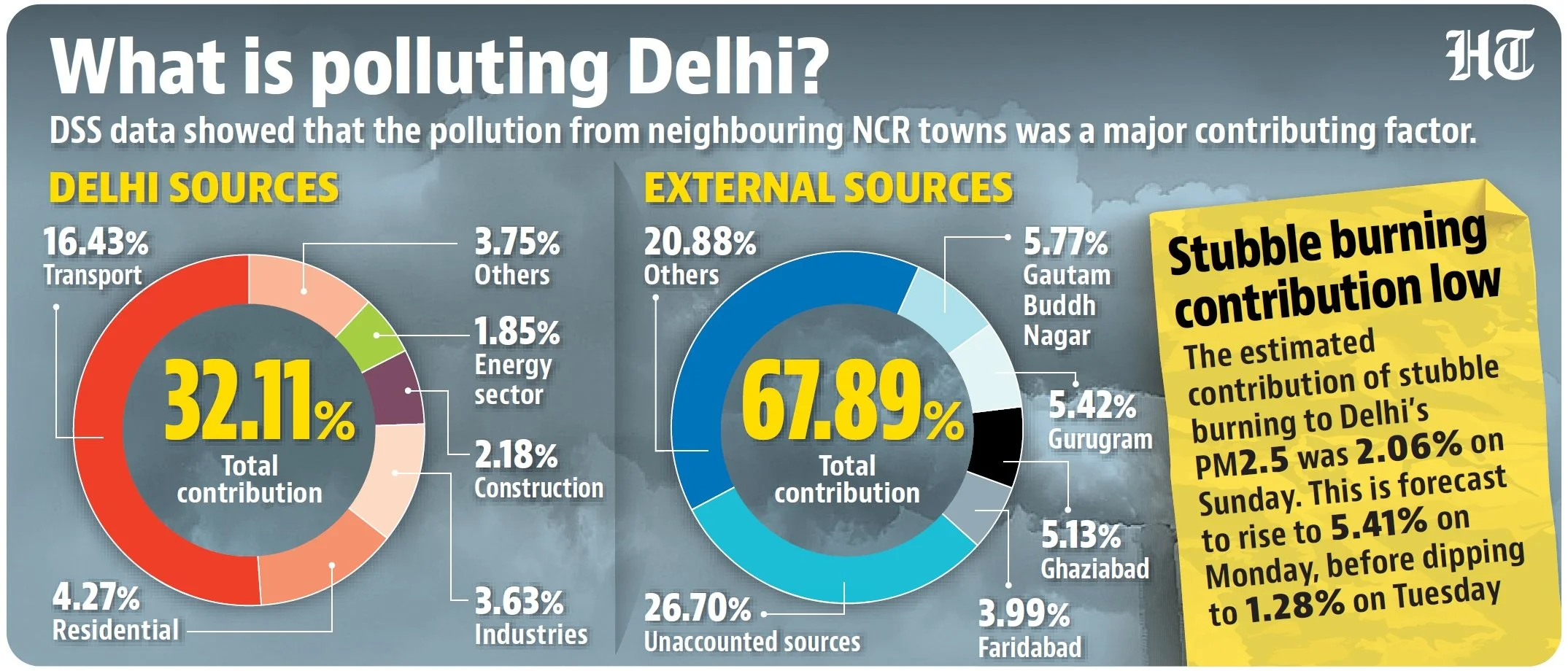What is polluting Delhi's air? Govt report reveals main factors behind 'very poor' AQI
The deterioration in Delhi’s air quality, which was skirting the “very poor” category on Sunday, was caused more by external factors than by sources within the capital, according to the Centre’s Decision Support System (DSS).
Data on Sunday showed that at least 67.89% of Delhi’s total PM2.5 contribution was from external sources.
The remaining 32.11% was attributed to pollution sources within the capital, primarily vehicular emissions. Interestingly, stubble burning — a key contributor to Delhi’s pollution load between October and November- was not among the top 5 contributors outside Delhi, adding only 2.06% of Delhi’s total pollution load on Sunday. Instead, DSS data showed, the pollution from neighbouring NCR towns is a major contributing factor.
The DSS — the city’s only operational pollution-tracking model, which gives an estimated contribution of sources to Delhi’s PM 2.5 — was reactivated only earlier this month after it was suspended last year over inaccuracies.
At the time of its reactivation, officials admitted that the system, run by the Indian Institute of Tropical Meteorology (IITM) in Pune, still operates on an outdated 2021 emissions inventory, raising questions over the accuracy of its forecasts.
According to Sunday’s data, the highest pollution load outside of Delhi was attributed to the ‘others’ category or unaccounted sources at 26.7%.
This was followed by cross-boundary pollution from Gautam Buddh Nagar (5.77%), Gurugram (5.42%) and Ghaziabad (5.13%), DSS said.
For the sources within Delhi, the transport sector in Delhi accounted for 16.43% of the pollution in the city, followed by Delhi’s residential sector (4.27%) and then the industries sector(3.63%). 2.18% of the PM2.5 pollution load came from construction in Delhi and 1.85% from energy production.
DSS forecasted that the share of stubble burning would rise marginally on Monday, touching 5.41% on Monday, before dipping to 1.28% on Tuesday. When farm fires are at their peak — typically in the last week of October and the first week of November, the share of stubble burning in Delhi’s air can shoot up between 35-45%.
Sunil Dahiya, founder and lead analyst at the think-tank Envirocatalysts, said calm weather conditions with decreased wind speed and falling temperature were leading to a build-up of high pollution levels in Delhi.
“The wind has been from the east and south-east direction and is expected to remain so for the next few days, meaning that the contribution of stubble burning, which is around 2-3% at the moment, is not expected to rise drastically during Diwali. Delhi and nearby regions have already started experiencing hazardous air quality during night hours and if the high emission load from firecracker bursting adds on to the already existing pollution levels, it is expected that the air quality will deteriorate to the severe category soon after Diwali,” Dahiya said, adding that local traffic and cross-boundary emissions from industries was a key source of pollution at present.
DSS was commissioned in 2018 alongside the Early Warning System for Delhi (EWS) by the Ministry of Earth Sciences (MoES). At the time, it was used to calculate the contribution of biomass burning to Delhi.
However, in 2021, on its formation, the Commission for Air Quality Management (CAQM) asked DSS to also look at other sources and incorporate the area outside Delhi, the current model.
Presently, it shares the sources of contribution to Delhi from both within and outside the capital, including from 19 NCR districts.
The DSS came under the scanner of the CAQM last year. On December 3, 2024, the commission suspended its operations, citing inaccuracies, and asked IITM to improve its model.
Operations resumed six days later, but CAQM clarified that DSS would not be used for pollution-related policy decisions until its accuracy improved.
Despite its flaws, researchers stressed that DSS is the only available tool, rendering it important.
Past source apportionment studies show that high vehicular emissions have been a key source of pollution in Delhi during the winter months.
A 2016 IIT, Kanpur, source apportionment study had identified biomass burning as the biggest source contributor in winters (26%), followed by vehicles (25%). It had pegged secondary particle formation – which occurs when pollutants mix with gases and form in the atmosphere – as a large chunk too (30%).
The 2018 source apportionment study by The Energy and Resources Institute (TERI) had meanwhile identified industries (30%), which included thermal power plants, as the biggest source of PM 2.5 pollution in winters, followed closely by vehicles (28%).


